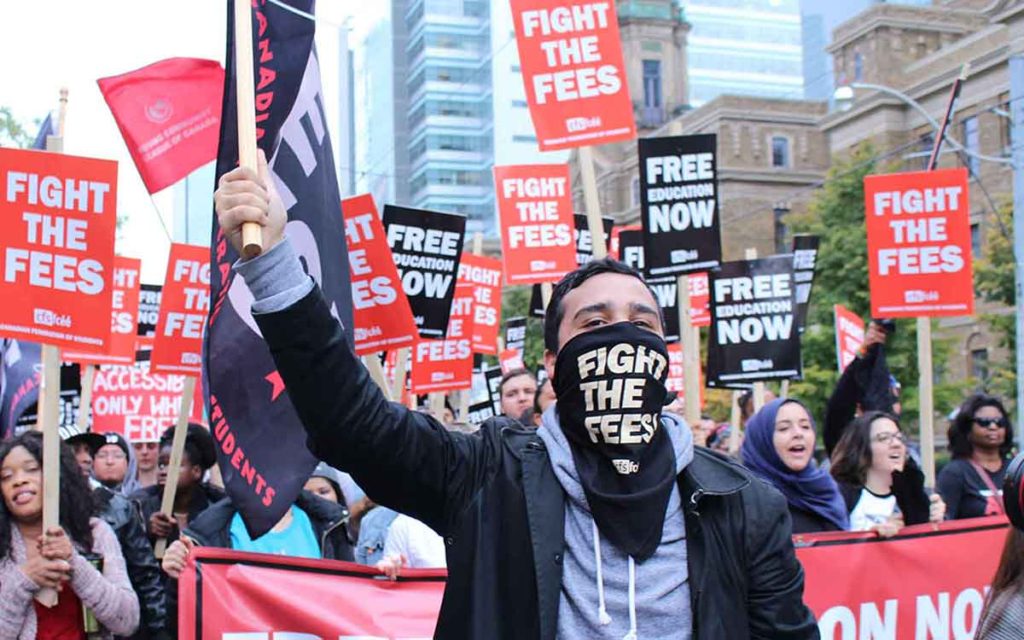
Post secondary students rally against changes to “free” post-secondary tuition.
Government entitlement programs are a bit like tattoos: if they turn out badly, it’s hard to get rid of them. That’s what happened with Ontario’s short-lived and failed experiment with so-called free tuition (or, more accurately, taxpayer funded tuition).
Once an entitlement is granted, recipients view it as a right and it becomes someone else’s obligation to pay for it. Rolling that entitlement back is a huge challenge, even if it has proved ineffective and unsustainable.
The reaction to the government’s decision to restore the Ontario Student Assistance Program funding model to 2016-17 levels has been furious. The next morning angry students and activists were protesting on the lawn of Queen’s Park and students are talking about going on strike. There have since been protests at campuses across Ontario and more are planned.
But the changes announced by the Ford government are the right thing to do. Not just for the province, which is faced with a $14.5 billion deficit. But it’s also the right thing for future students.
The free tuition program had changed OSAP from a repayable loan program into a grant program, with 98 per cent of financial aid for students being handed out as non-repayable grants. As a result, the cost of OSAP to taxpayers increased by 50 percent since the changes came into effect. The program went from costing $1.3 billion per year to more than $2 billion per year.
OSAP was not designed to be free tuition, it was designed to be a student assistance program that provides low interest loans to students who would not otherwise qualify for a regular bank loan. The grant portion of the program was intended for students with the greatest financial need. The free tuition pledge warped the program and ended up handing out grants to students from high income families at the expense of taxpayers and the sustainability of OSAP.
But the cost of the free tuition pledge is not the only issue: The free tuition program has also failed to achieve its goals.
The purpose of the free tuition pledge was to increase enrollment. But the auditor general found that this didn’t happen. University and college enrollment stayed essentially flat while costs ballooned.
While new students were not enrolling in higher numbers, existing students were suddenly getting financial aid; 24 per cent for university and 27 per cent for college. Overnight, many students who were previously not on OSAP, or who were taking out loans, suddenly became eligible for grants. The program changes didn’t result in more students heading to university – it resulted in students already in university overnight being handed free money.
The worst part is that it was actually supposed to save taxpayers money. The elimination of Ontario’s Tuition and Education Tax Credits was supposed to more than offset the increased costs of the changes to OSAP. The government predicted a savings for taxpayers of $246 million by 2020-21.
Instead, the opposite happened and the cost of the program increased by 50 percent. This is because poor program design failed to account for an increase in grants, even though the purpose of the changes was to increase uptake.
The free tuition program distorted the purpose of OSAP and dishonestly switched student debt for soaring government debt. Amending the program to increase the focus on loans and focus on students with the most financial need is the right thing to do.
It’s not unreasonable to ask students to pay for a share of their own education in the form of low interest repayable loans and to focus grants where they are needed most. Nor is it revolutionary – it’s simply reverting to the 2016-17 status quo. But the reaction to reversal shows an ill-considered entitlement program can be worse than a lower-back dolphin tattoo.

Christine Van Geyn is the Ontario Director for the Canadian Taxpayers Federation.




















